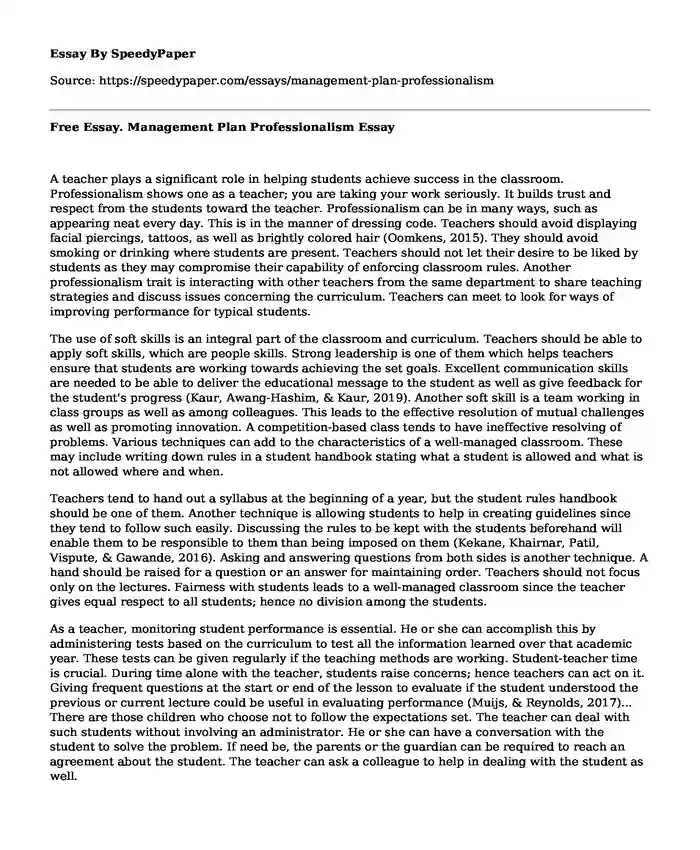
| Type of paper: | Course work |
| Categories: | Teaching Behavior Communication skills Classroom management |
| Pages: | 3 |
| Wordcount: | 692 words |
A teacher plays a significant role in helping students achieve success in the classroom. Professionalism shows one as a teacher; you are taking your work seriously. It builds trust and respect from the students toward the teacher. Professionalism can be in many ways, such as appearing neat every day. This is in the manner of dressing code. Teachers should avoid displaying facial piercings, tattoos, as well as brightly colored hair (Oomkens, 2015). They should avoid smoking or drinking where students are present. Teachers should not let their desire to be liked by students as they may compromise their capability of enforcing classroom rules. Another professionalism trait is interacting with other teachers from the same department to share teaching strategies and discuss issues concerning the curriculum. Teachers can meet to look for ways of improving performance for typical students.
The use of soft skills is an integral part of the classroom and curriculum. Teachers should be able to apply soft skills, which are people skills. Strong leadership is one of them which helps teachers ensure that students are working towards achieving the set goals. Excellent communication skills are needed to be able to deliver the educational message to the student as well as give feedback for the student's progress (Kaur, Awang-Hashim, & Kaur, 2019). Another soft skill is a team working in class groups as well as among colleagues. This leads to the effective resolution of mutual challenges as well as promoting innovation. A competition-based class tends to have ineffective resolving of problems. Various techniques can add to the characteristics of a well-managed classroom. These may include writing down rules in a student handbook stating what a student is allowed and what is not allowed where and when.
Teachers tend to hand out a syllabus at the beginning of a year, but the student rules handbook should be one of them. Another technique is allowing students to help in creating guidelines since they tend to follow such easily. Discussing the rules to be kept with the students beforehand will enable them to be responsible to them than being imposed on them (Kekane, Khairnar, Patil, Vispute, & Gawande, 2016). Asking and answering questions from both sides is another technique. A hand should be raised for a question or an answer for maintaining order. Teachers should not focus only on the lectures. Fairness with students leads to a well-managed classroom since the teacher gives equal respect to all students; hence no division among the students.
As a teacher, monitoring student performance is essential. He or she can accomplish this by administering tests based on the curriculum to test all the information learned over that academic year. These tests can be given regularly if the teaching methods are working. Student-teacher time is crucial. During time alone with the teacher, students raise concerns; hence teachers can act on it. Giving frequent questions at the start or end of the lesson to evaluate if the student understood the previous or current lecture could be useful in evaluating performance (Muijs, & Reynolds, 2017)... There are those children who choose not to follow the expectations set. The teacher can deal with such students without involving an administrator. He or she can have a conversation with the student to solve the problem. If need be, the parents or the guardian can be required to reach an agreement about the student. The teacher can ask a colleague to help in dealing with the student as well.
In conclusion, to enjoy teaching and have a productive career, teachers should have classroom management skills. Professionalism should be accompanied by well-monitored student performance. This way, the students will not only benefit but also the teachers will have an easy time teaching.
References
Kaur, A., Awang-Hashim, R., & Kaur, M. (2019). Students' experiences of co-creating classroom instruction with a faculty-a case study in eastern context. Teaching in Higher Education, 24(4), 461-477.
Kekane, S., Khairnar, D., Patil, R., Vispute, S. R., & Gawande, N. (2016). Automatic student performance analysis and monitoring. Int. J. Innovative, Res. Comput. Commun. Eng.
Muijs, D., & Reynolds, D. (2017). Effective teaching: Evidence and practice. Sage.
Oomkens, R. F. (2015). Professionalism & Performance-based Contracting: Transparency, accountability, or interference? (Doctoral dissertation, Utrecht University).
Cite this page
Free Essay. Management Plan Professionalism. (2023, Mar 30). Retrieved from https://speedypaper.net/essays/management-plan-professionalism
Request Removal
If you are the original author of this essay and no longer wish to have it published on the SpeedyPaper website, please click below to request its removal:
Popular categories




